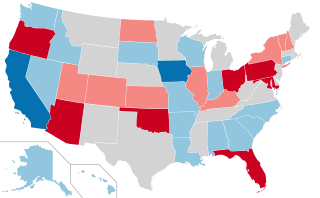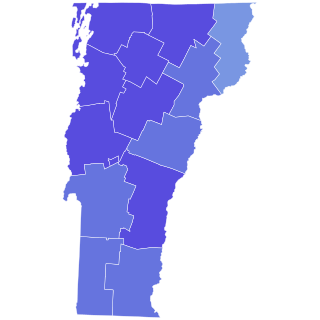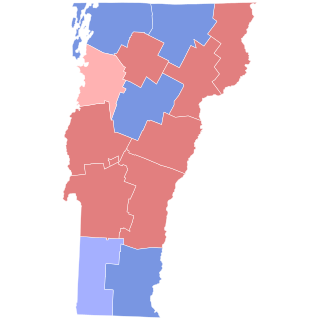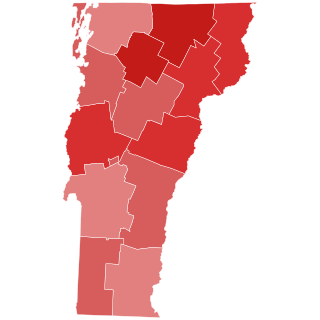
Warren Robinson Austin was an American politician and diplomat who served as United States Senator from Vermont and U.S. Ambassador to the United Nations.

The 1968 United States Senate elections were elections for the United States Senate. Held on November 5, the 34 seats of Class 3 were contested in regular elections. They coincided with the presidential election of the same year. The Republicans picked up five net seats in the Senate. This saw Republicans win a Senate seat in Florida for the first time since Reconstruction.

The 1958 United States Senate elections were elections for the United States Senate which occurred in the middle of President Dwight D. Eisenhower's second term. Thirty-two seats of Class 1 were contested in regular elections, the new state of Alaska held its first Senate elections for its Class 2 and 3 seats, and two special elections were held to fill vacancies.

The 1998 United States Senate election in Vermont was held November 3, 1998. Incumbent Democratic U.S. Senator Patrick Leahy won reelection to a fifth term.

The 1932 United States Senate election in Vermont took place on November 8, 1932. Republican Porter H. Dale successfully ran for re-election to another term in the United States Senate, defeating Democratic candidate Fred C. Martin. Dale died in October 1933, vacating the seat until a special election was held in January 1934.

The 1922 United States Senate election in Vermont took place on November 7, 1922. Incumbent Republican Carroll S. Page did not run for re-election to another term in the United States Senate. Republican candidate Frank L. Greene defeated Democratic candidate William B. Mayo to succeed him.

The 1982 United States Senate election in Vermont took place on November 2, 1982. Incumbent Republican Senator Robert Stafford successfully ran for re-election to a third term in office, defeating Democratic candidate and former Vermont Secretary of State James A. Guest.

The 1976 United States Senate election in Vermont took place on November 2, 1976. Incumbent Republican Robert Stafford successfully ran for re-election to another term in the United States Senate, defeating Democratic candidate Governor Thomas P. Salmon.

The 1970 United States Senate election in Vermont took place on November 3, 1970. Incumbent Republican Winston L. Prouty successfully ran for re-election to third term in the United States Senate, defeating Former Democratic Governor Philip H. Hoff.

The 1972 United States Senate special election in Vermont took place on January 7, 1972. Incumbent Republican Robert Stafford, appointed in September 1971 to fill the vacancy created by the death of Winston L. Prouty, successfully ran for election to the remainder of Prouty's term in the United States Senate. Stafford defeated Democratic candidate Randolph T. Major. Liberty Union candidate Bernie Sanders received 2% of the vote and was later elected to this seat in 2006 as an independent.

The 1964 United States Senate election in Vermont took place on November 3, 1964. Incumbent Republican Winston L. Prouty successfully ran for re-election to another term in the United States Senate, defeating Democratic candidate Frederick J. Fayette.

The 1958 United States Senate election in Vermont took place on November 4, 1958. Incumbent Republican Ralph Flanders did not run for re-election to another term in the United States Senate. Republican candidate Winston L. Prouty defeated Democratic candidate Frederick J. Fayette to succeed him.

The 1952 United States Senate election in Vermont took place on November 4, 1952. Incumbent Republican Ralph Flanders successfully ran for re-election to another term in the United States Senate, defeating Democratic candidate Allan R. Johnston.

The 1946 United States Senate election in Vermont took place on November 5, 1946. Incumbent Republican Ralph Flanders successfully ran for re-election to a full term in the United States Senate, defeating Democratic candidate Charles P. McDevitt.

The 1940 United States Senate election in Vermont took place on November 5, 1940. Incumbent Republican Warren Austin successfully ran for re-election to another term in the United States Senate, defeating Democratic candidate Ona S. Searles. Austin would resign in August 1946 to become United States Ambassador to the United Nations; Ralph Flanders was appointed to replace him and went on to win election to a full term in 1946.

The 1931 United States Senate special election in Vermont took place on March 31, 1931. Republican Warren Austin was elected to the United States Senate to serve the remainder of the deceased Frank L. Greene's term, defeating Democratic candidate Stephen M. Driscoll. Austin replaced Frank C. Partridge, who was appointed to fill the seat until a special election could be held and was defeated in the special primary.

The 1928 United States Senate election in Vermont took place on November 6, 1928. Incumbent Republican Frank L. Greene successfully ran for re-election to another term in the United States Senate, defeating Democratic candidate Fred C. Martin. Greene died in December 1930 and Frank C. Partridge was appointed to fill the seat until a special election could be held in March 1931.

The 1916 United States Senate election in Vermont took place on November 7, 1916. Incumbent Republican Carroll S. Page successfully ran for re-election to another term in the United States Senate, defeating Democratic candidate Oscar C. Miller. This was the second United States Senate direct election to take place in Vermont following the ratification of the Seventeenth Amendment to the United States Constitution and the first for Vermont's Class I seat.

The 1968 United States Senate election in Vermont took place on November 5, 1968. Incumbent Republican George Aiken ran successfully for re-election to another term in the United States Senate; he was unopposed. As of 2024, this is the last time the Republicans won the Class 3 Senate seat in Vermont.

The United States Senate special election of 1938 in New Jersey was held on November 8, 1938.























